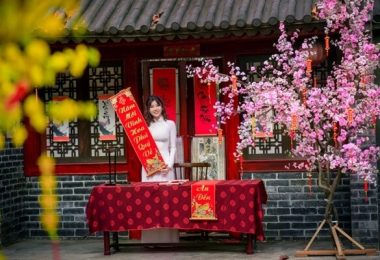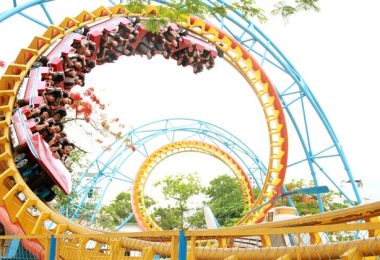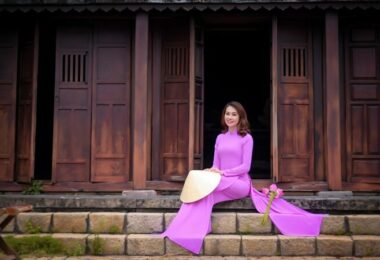With a history spanning over 2,000 years, Buddhism is Vietnam’s largest religion, deeply woven into the culture through its many temples and pagodas, each rich in history and artistic value. Here are some iconic pagodas you cannot miss when exploring Vietnam.
1. One Pillar Pagoda – Hanoi
Address: Chua Mot Cot Street, Doi Can Ward, Ba Dinh District, Hanoi, Vietnam
Opening hours: 7:00 am – 6:00 pm
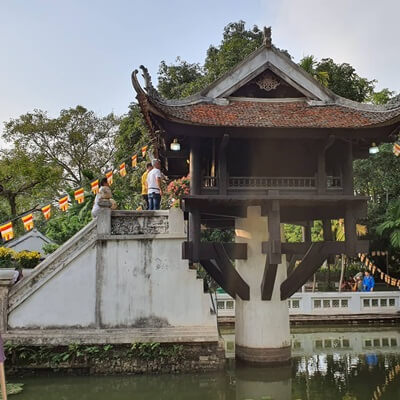
Nestled in the heart of Hanoi, near the Ho Chi Minh Museum, One Pillar Pagoda—also called Dien Huu Tu or Lien Hoa Dai—stands as a symbol of elegance and wisdom. Its unique design features a square temple balanced atop a single stone pillar, appearing to float gracefully on the surrounding pond.
Inside the lotus-shaped structure lies a gilded statue of Avalokitesvara Buddha, radiating serenity. Though small in size, the pagoda’s charm and distinctive architecture reflect deep Asian yin-yang philosophy—the square base represents yin, and the round pillar embodies yang.
One Pillar Pagoda is more than just an architectural marvel; it captures the gentle, timeless spirit of Buddhist tradition.
2. Tran Quoc Pagoda – Hanoi
Address: Thanh Nien Street, Yen Phu Ward, Tay Ho District, Hanoi, Vietnam
Opening hours: 8:00 am – 4:00 pm
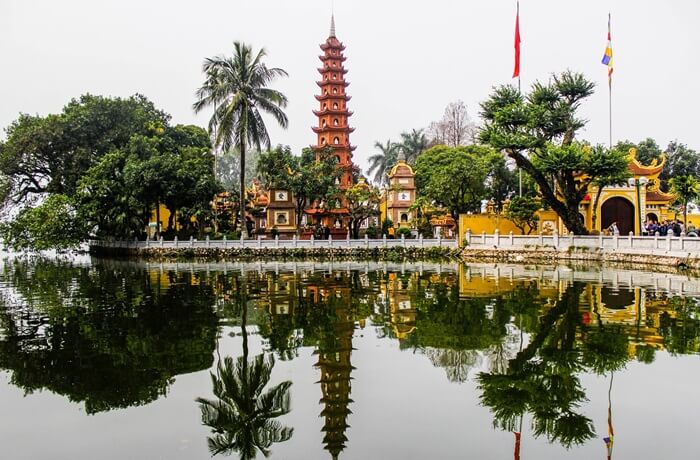
Tran Quoc Pagoda, Hanoi’s oldest temple at 1,500 years old, sits serenely on a small island at the eastern edge of West Lake. Surrounded by lush gardens and calm waters, its setting perfectly blends natural beauty with historical grandeur.
The temple’s architecture resembles a blooming lotus, echoing the sacred symbol of Buddha. Visitors enter a spacious red-brick courtyard, centered with a large incense burner where both Buddhists and tourists pay respects. Inside, the temple houses exquisite statues of Buddhas and Bodhisattvas, with the centerpiece being a golden-painted wooden statue of Buddha entering Nirvana—a highlight of artistic and spiritual value.
Tran Quoc’s timeless charm and harmony with its environment earned it recognition as one of the world’s most beautiful temples by travel experts.
3. Perfume Pagoda – Hanoi
Address: Huong Son, My Duc District, Hanoi, Vietnam (about 65 km from Hanoi center)
Opening hours: 7:00 am – 5:00 pm
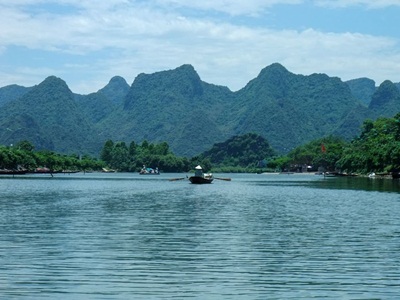
Nestled amid serene mountains and lush landscapes, Perfume Pagoda is a spiritual haven and a must-visit pilgrimage site. The main festival, held from the full moon of the first lunar month to the 18th day of the second lunar month, draws millions seeking luck and happiness for the new year. It is not only Hanoi’s largest New Year festival but also one of Vietnam’s most celebrated cultural events.
The Perfume Pagoda complex offers a day full of exploration: marvel at Huong Tich Cave, visit Trinh Temple, and admire Thien Tru Pagoda—all easily reachable in a day trip from Hanoi. The journey combines natural beauty with spiritual serenity, making it a truly memorable experience.
4. Bai Dinh Pagoda – Ninh Binh
Address: Gia Sinh Commune, Gia Vien District, Ninh Binh Province, Vietnam
Opening hours: 6:00 am – 10:00 pm
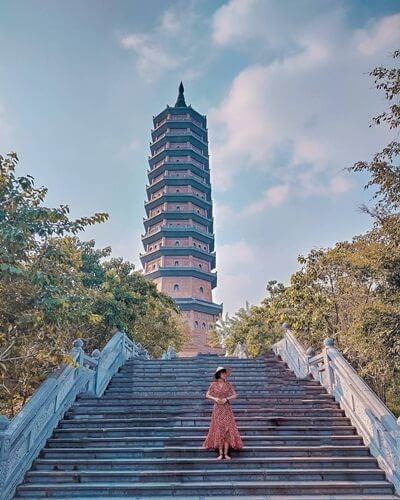
Perched on Bai Dinh Mountain, between valleys, lakes, and rocky peaks, Bai Dinh Pagoda is a majestic gateway to the ancient Hoa Lu capital. Just 12 km from Ninh Binh city, the complex spans two areas: the ancient pagoda with historical sites such as Sang Cave, Dark Cave, Saint Nguyen Temple, Cao Son God Temple, and Ngoc Well; and the new pagoda area, home to massive architectural marvels like Tam The Palace, Phap Chu Palace, Quan Am Palace, Bao Thap, the Bell Tower, and the towering Maitreya Buddha, crafted from local bluestone and ironwood.
Bai Dinh Pagoda is the largest temple complex in Southeast Asia. Its festival, beginning on the 1st day of Tet and officially opening on the 6th day of the Lunar New Year until March’s end, features solemn spiritual ceremonies—a perfect time for a meaningful journey of reflection and devotion.
5. Ba Vang Pagoda – Quang Ninh
Address: Ba Vang Mountain, Quang Trung Ward, Uong Bi City, Quang Ninh Province, Vietnam
Opening hours: 7:00 am – 8:00 pm
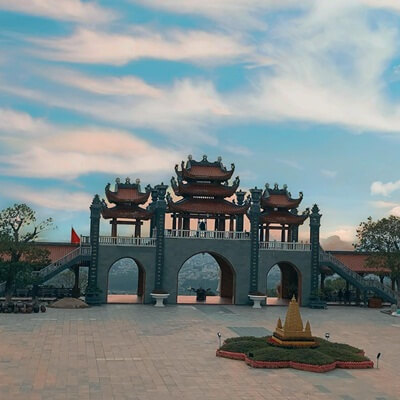
Rising 340 meters above sea level, Ba Vang Pagoda captivates visitors with its dramatic northern Vietnamese landscape: Thanh Long (Blue Dragon) and Bach Ho (White Tiger) mountains flank the site, a river flows gently in front, and pine forests stretch behind.
The pagoda complex features three pavilions and a main temple with altars for Buddha, Mother Goddess, and Duc Ong, housing Vietnam’s largest main hall. The best time to visit is the 8th day of the first lunar month, when the festival begins, buzzing with vibrant spiritual activities. Another enchanting period is the 9th day of the 9th lunar month, during the Chrysanthemum Festival (Trung Cuu Festival), a celebration of ancient Vietnamese tradition.
6. Thien Mu Pagoda – Hue City
Address: Ha Khe Hill, Huong Long Commune, Huong Hoa District, Hue City (4 km from Hue city center)
Opening hours: 7:00 am – 5:00 pm
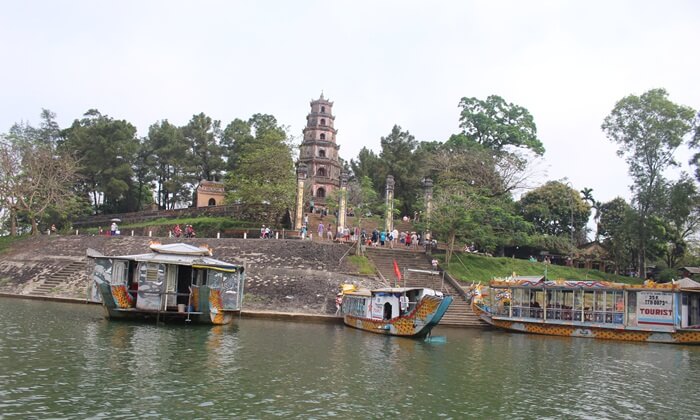
Perched gracefully on Ha Khe Hill along the north bank of the Perfume River, Thien Mu Pagoda—also known as Linh Mu or the Heavenly Lady Pagoda—is a symbol of Hue’s spiritual heritage. Established in 1601 and restored in 1714, it is considered the most sacred temple in the city.
The pagoda’s grounds feature a seven-story tower, the main temple, and the Hell God Temple, along with the impressive Dai Hong Chung (Great Bell) weighing nearly two tons. Amid pine trees, bonsai, and a serene lake, visitors can soak in the peaceful atmosphere while admiring the winding Perfume River and the lush surrounding countryside.
Thien Mu Pagoda offers a perfect blend of traditional Hue royal architecture and natural beauty, making it an essential stop for travelers.
7. Linh Ung Pagoda – Da Nang
Address: Bai But, Son Tra Peninsula, Son Tra District, Da Nang City (10 km from city center)
Opening hours: 7:00 am – 5:00 pm
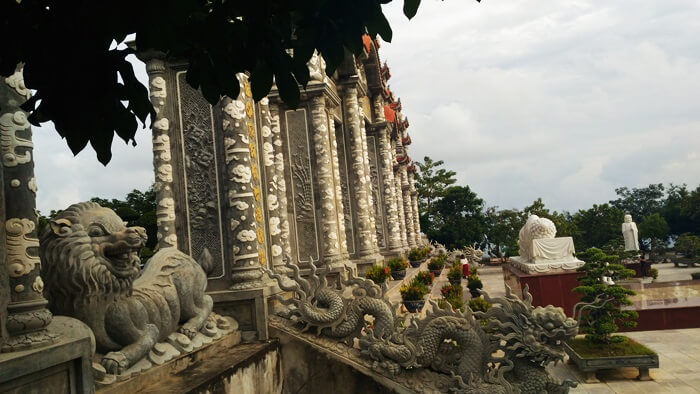
Halfway up Son Tra Mountain, shaped like a turtle, Linh Ung Pagoda rises 693 meters above sea level, offering sweeping views of the ocean, city, and sky. The sea breeze adds a refreshing touch as you explore its tranquil grounds.
The complex includes an ancestral house, monastery, library, main hall, and lecture hall, but the crowning glory is the 67-meter-tall statue of Quan The Am (Guanyin) with a 35-meter lotus base—the tallest statue in Vietnam.
Visitors come to Linh Ung not only for its majestic architecture but also to admire the panorama of Da Nang and Son Tra Peninsula and seek a moment of peace and reflection.
8. Ba Thien Hau Temple – Binh Duong
Address: 4 Nguyen Du Street, Phu Cuong Ward, Thu Dau Mot District, Binh Duong Province, Vietnam
Opening hours: 7:00 am – 5:00 pm
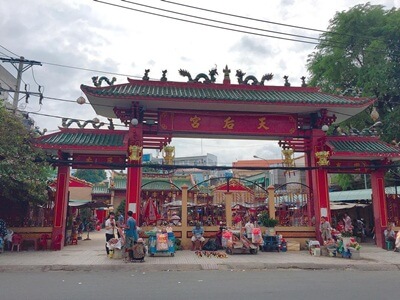
Ba Thien Hau Temple, also known as Ba Binh Duong Pagoda, is a charming site established in 1923 by Vietnamese-Chinese communities, dedicated to Thien Hau Thanh Mau. Its bold Chinese architectural style—with intricate roof tiles, walls, and ornate decorations—creates a truly immersive cultural experience.
The temple features a three-way entrance, two side corridors, and a main hall centered around the statue of Thien Hau, illuminated by golden light and flickering candles, casting a serene, spiritual glow.
The temple becomes especially lively during the Lunar New Year and the Ba Pagoda Festival on the full moon of the first lunar month, drawing crowds of devotees and visitors seeking blessings and tranquility.
9. Ba Chua Xu Pagoda – An Giang
Address: Foot of Sam Mountain, Chau Doc City, An Giang Province, Vietnam
Opening hours: 7:00 am – 5:00 pm
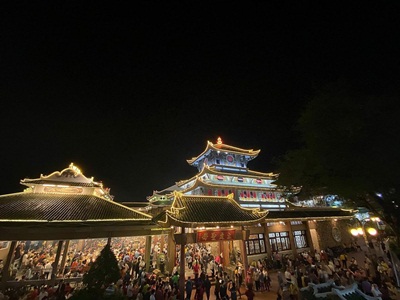
Nestled at the base of the scenic Sam Mountain, Ba Chua Xu Pagoda is a spiritual gem of the Mekong Delta. Built over 200 years ago after the discovery of Ba’s statue, the temple has grown from a simple bamboo-roofed structure into a spacious and beautifully arranged complex.
The pagoda’s harmonious layout features blue-tiled, three-tiered roofs with corners that curve gracefully like a sailing boat. From the first to the fourth lunar month, the temple fills with pilgrims seeking blessings and good fortune. Its annual festival, held from the 24th to the 27th of the fourth lunar month, draws thousands of visitors, making it one of the region’s most famous spiritual destinations, welcoming nearly two million visitors each year.
10. Vinh Nghiem Pagoda – Ho Chi Minh City
Address: 339 Nam Ky Khoi Nghia Street, Ward 7, District 3, Ho Chi Minh City, Vietnam
Opening hours: 7:00 am – 5:00 pm
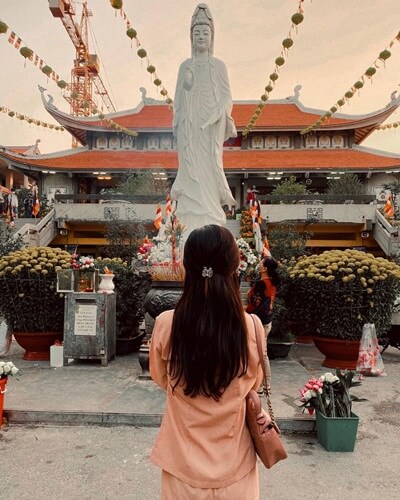
Vinh Nghiem Pagoda, built in 1964 across 6,000 m², is a striking blend of northern classical temple architecture and modern materials. The main gate, with its traditional red-tiled roof and elegant curves, welcomes visitors into a serene spiritual space.
The pagoda’s architectural highlight is the seven-story Quan The Am Tower, standing nearly 40 meters tall beside the Buddha hall, accompanied by exquisitely carved wooden Buddha statues throughout the temple. This harmonious combination of artistry and spirituality makes Vinh Nghiem Pagoda a must-visit destination for those seeking peace amidst the bustling city.
These temples are not only remarkable architectural works but also serene sanctuaries for anyone seeking tranquility and reflection.
Which of these beautiful Vietnamese pagodas would you most like to visit?

